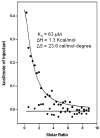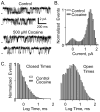Potential role of cardiac calsequestrin in the lethal arrhythmic effects of cocaine
- PMID: 23876860
- PMCID: PMC4097383
- DOI: 10.1016/j.drugalcdep.2013.06.012
Potential role of cardiac calsequestrin in the lethal arrhythmic effects of cocaine
Abstract
Background: Cocaine-related deaths are continuously rising and its overdose is often associated with lethal cardiotoxic effects.
Methods and results: Our approach, employing isothermal titration calorimetry (ITC) and light scattering in parallel, has confirmed the significant affinity of human cardiac calsequestrin (CASQ2) for cocaine. Calsequestrin (CASQ) is a major Ca(2+)-storage protein within the sarcoplasmic reticulum (SR) of both cardiac and skeletal muscles. CASQ acts as a Ca(2+) buffer and Ca(2+)-channel regulator through its unique Ca(2+)-dependent oligomerization. Equilibrium dialysis and atomic absorption spectroscopy experiments illustrated the perturbational effect of cocaine on CASQ2 polymerization, resulting in substantial reduction of its Ca(2+)-binding capacity. We also confirmed the accumulation of cocaine in rat heart tissue and the substantial effects cocaine has on cultured C2C12 cells. The same experiments were performed with methamphetamine as a control, which displayed neither affinity for CASQ2 nor any significant effects on its function. Since cocaine did not have any direct effect on the Ca(2+)-release channel judging from our single channel recordings, these studies provide new insights into how cocaine may interfere with the normal E-C coupling mechanism with lethal arrhythmogenic consequences.
Conclusion: We propose that cocaine accumulates in SR through its affinity for CASQ2 and affects both SR Ca(2+) storage and release by altering the normal CASQ2 Ca(2+)-dependent polymerization. By this mechanism, cocaine use could produce serious cardiac problems, especially in people who have genetically-impaired CASQ2, defects in other E-C coupling components, or compromised cocaine metabolism and clearance.
Keywords: CASQ; CPVT; Calsequestrin; Cocaine; ITC; K(d); Methamphetamine; RYR; Ryanodine receptor; SR; Sarcoplasmic reticulum; calsequestrin; catecholamine-induced polymorphic ventricular tachycardia; dissociation constant; isothermal titration calorimetry; ryanodine receptor; sarcoplasmic reticulum.
Copyright © 2013 Elsevier Ireland Ltd. All rights reserved.
Conflict of interest statement
Authors have no conflict of interest.
Figures







Similar articles
-
Potential adverse interaction of human cardiac calsequestrin.Eur J Pharmacol. 2010 Nov 10;646(1-3):12-21. doi: 10.1016/j.ejphar.2010.08.001. Epub 2010 Aug 14. Eur J Pharmacol. 2010. PMID: 20713040
-
Modulation of sarcoplasmic reticulum calcium release by calsequestrin in cardiac myocytes.Biol Res. 2004;37(4):603-7. doi: 10.4067/s0716-97602004000400014. Biol Res. 2004. PMID: 15709687
-
Calsequestrin 2 (CASQ2) mutations increase expression of calreticulin and ryanodine receptors, causing catecholaminergic polymorphic ventricular tachycardia.J Clin Invest. 2007 Jul;117(7):1814-23. doi: 10.1172/JCI31080. J Clin Invest. 2007. PMID: 17607358 Free PMC article.
-
Calsequestrin 2 and arrhythmias.Am J Physiol Heart Circ Physiol. 2012 Mar 15;302(6):H1250-60. doi: 10.1152/ajpheart.00779.2011. Epub 2011 Dec 23. Am J Physiol Heart Circ Physiol. 2012. PMID: 22198169 Free PMC article. Review.
-
Calsequestrin, a key protein in striated muscle health and disease.J Muscle Res Cell Motil. 2021 Jun;42(2):267-279. doi: 10.1007/s10974-020-09583-6. Epub 2020 Jun 2. J Muscle Res Cell Motil. 2021. PMID: 32488451 Review.
Cited by
-
Emerging Arrhythmic Risk of Autoimmune and Inflammatory Cardiac Channelopathies.J Am Heart Assoc. 2018 Nov 20;7(22):e010595. doi: 10.1161/JAHA.118.010595. J Am Heart Assoc. 2018. PMID: 30571503 Free PMC article. Review. No abstract available.
-
Cocaine-Responsive miRNA and Blood Pressure Elevation.Hypertension. 2018 Apr;71(4):561-562. doi: 10.1161/HYPERTENSIONAHA.118.10278. Epub 2018 Feb 26. Hypertension. 2018. PMID: 29483229 Free PMC article. No abstract available.
-
Stimulant Drugs of Abuse and Cardiac Arrhythmias.Circ Arrhythm Electrophysiol. 2022 Jan;15(1):e010273. doi: 10.1161/CIRCEP.121.010273. Epub 2021 Dec 28. Circ Arrhythm Electrophysiol. 2022. PMID: 34961335 Free PMC article. Review.
-
First Insight on Small Molecules as Cardiac Calsequestrin Stabilizers.ACS Omega. 2019 Jul 2;4(7):11508-11514. doi: 10.1021/acsomega.9b01113. eCollection 2019 Jul 31. ACS Omega. 2019. PMID: 31460256 Free PMC article.
-
Unintentional drug overdose deaths involving cocaine among middle-aged and older adults in New York City.Drug Alcohol Depend. 2019 May 1;198:121-125. doi: 10.1016/j.drugalcdep.2019.01.042. Epub 2019 Mar 14. Drug Alcohol Depend. 2019. PMID: 30909019 Free PMC article.
References
-
- Andrews J, Nemeroff C. Contemporary management of depression. Am J Med. 1994;97:24S–32S. - PubMed
-
- Basso C, Marra MP, Thene G. Cocaine and the heart; more than just coronary disease. Heart. 2011;97:1995–1996. - PubMed
-
- Bauman J, Grawe J, Winecoff A, Hariman R. Cocaine-related sudden cardiac death: a hypothesis correlating basic science and clinical observations. J Clin Pharmacol. 1994;34:902–911. - PubMed
-
- Berchtold M, Brinkmeier H, Muntener M. Calcium ion in skeletal muscle: its crucial role for muscle function, plasticity, and disease. Physiol Rev. 2000;80:1215–1265. - PubMed
Publication types
MeSH terms
Substances
Grants and funding
LinkOut - more resources
Full Text Sources
Other Literature Sources
Medical
Molecular Biology Databases
Research Materials
Miscellaneous

